In the past I’ve mentioned a strategy I often use for photographing songbirds in flight but I’ve never explained it. Sometimes it works and sometimes it doesn’t. When I used it two days ago my batting average went down but I’ll continue to use it and play the odds.
For what it’s worth here’s the rationale for my strategy and a couple of examples of when it didn’t work. After all, we can learn as much from our failures as we can from our successes.
Songbirds are small, erratic and incredibly fast – too fast to follow and keep active focus points on in flight. When I attempt to keep my focus points on them they nearly always lose the bird and focus on the background or something else, resulting in a soft bird.
So my strategy is often to focus on them while they’re perched and then take my finger off of the focusing button (I use back button AF) and hope they take off at right angles to me. If they do they’ll be in the same plane in early flight as when they were perched so if I have enough shutter speed my first few shots of them in flight have a good chance of being sharp.
Think about it. There’s four basic directions they’re most likely to take off:
- Away from me: My strategy doesn’t work here but all I’ve lost is butt shots which I’d almost certainly delete anyway.
- To my right or to my left: In both of these situations I have reasonably good potential for getting sharp flight shots.
- Toward me: This is the weakest part of my strategy. Some head-on flight shots can be pretty spectacular but using this strategy I have little chance of getting them sharp because my focusing points aren’t active as the bird approaches me. But a bird perched close to me is less likely to take off in my direction because birds are shy and have a natural avoidance reaction to humans.
I believe that playing the odds gives me the best chance of getting sharp flight shots and experience has borne that out. But that’s not to say it doesn’t sting when a bird does take off in my direction and it’s soft because I didn’t have my focus points active.
Usually I post my photographic successes to Feathered Photography but I intend today’s post to be a learning opportunity for novice bird photographers so in this context I think the following failures have their value.
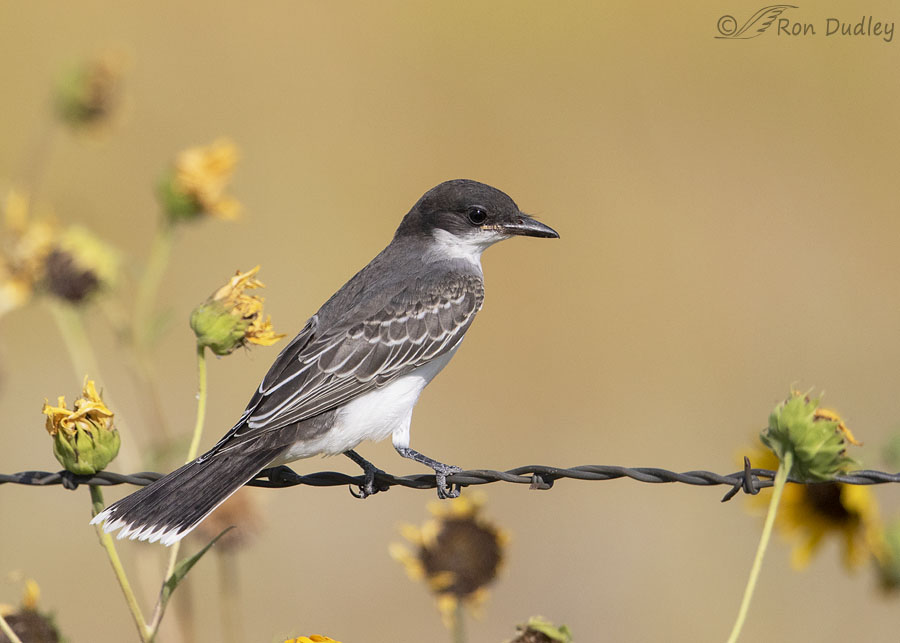
Two days ago I hoped to get takeoff and flight shots of this Eastern Kingbird hunting insects from a barbed wire fence. If ‘he’ had been facing me while perched I’d have kept my focus points active but he was facing to my right so after focusing on him I took my thumb off the focusing button and hoped he’d take off in the direction he was looking (which would be in the same plane I’d already focused on). .
He didn’t.
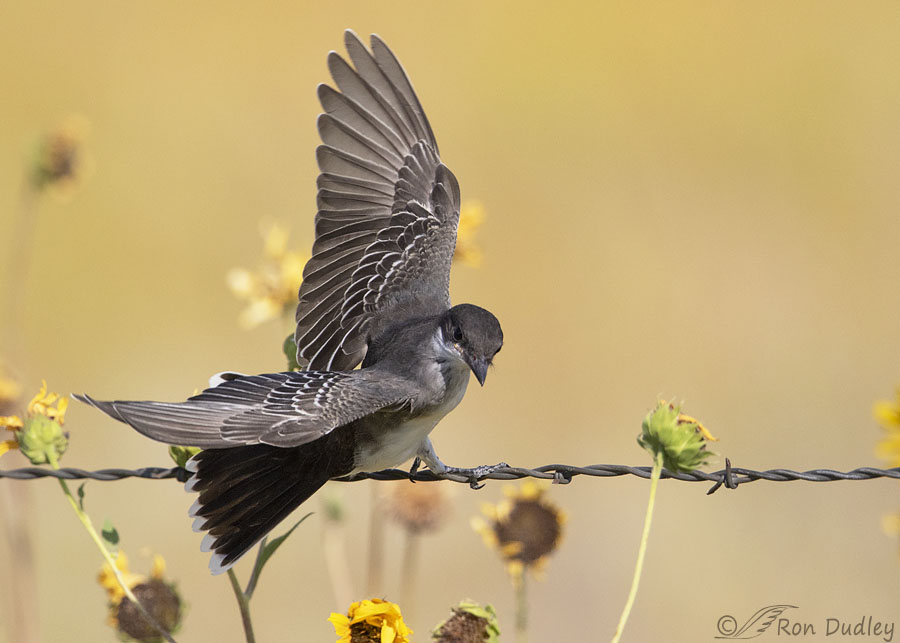
Instead he turned on his perch and came toward me.
Apparently he’d spotted an insect below him and to his right so he went after it. This first shot in the burst is acceptably sharp because he was still pretty close to my original plane of focus. However, I normally wouldn’t keep this photo because I didn’t get a catch light in his eye.
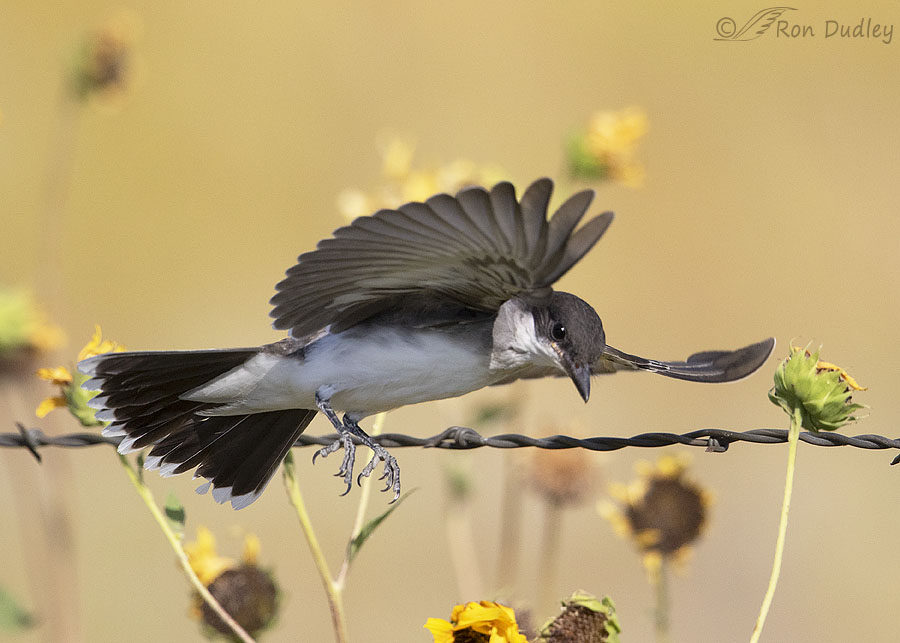
But the next shot is just a little too soft to be salvageable, even after I’d applied twice my normal amount of sharpening during processing. Unprocessed it’s even softer.
At this point the bird apparently changed his mind about going after the insect so he hovered here for about two wingbeats instead of continuing his dive after the bug.
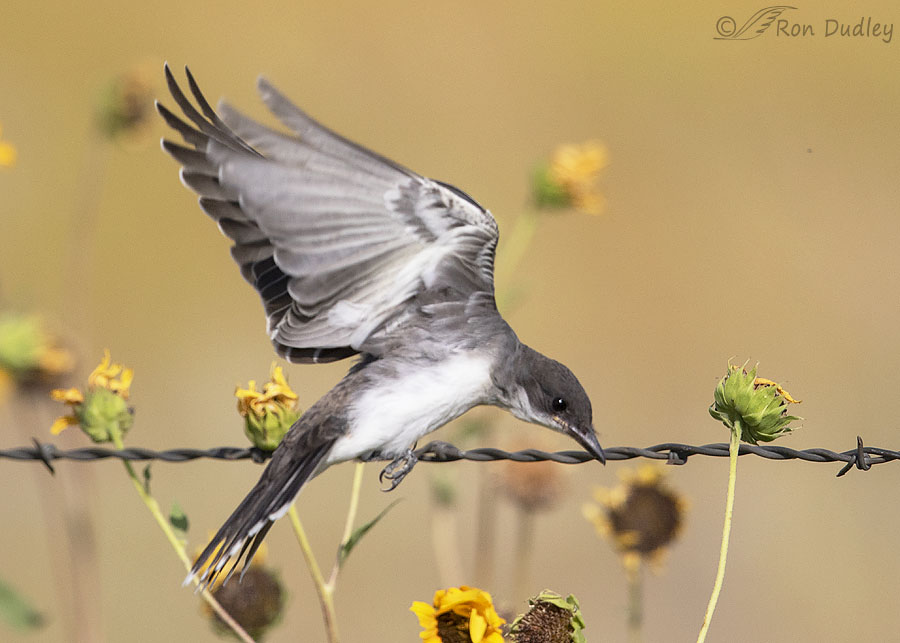
This next shot is also too soft, for the same reason as the previous photo – my focus points weren’t active.
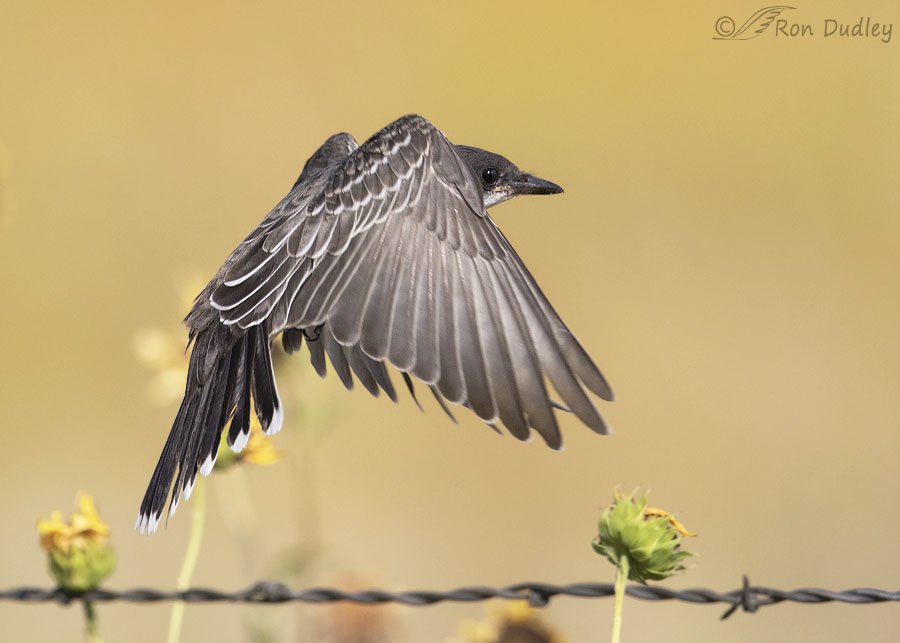
The fourth and last photo is sharp enough because by now I realized what was happening so I reactivated my focus points.
But what could have been the two best shots in the series (#2 and #3) are just too soft.
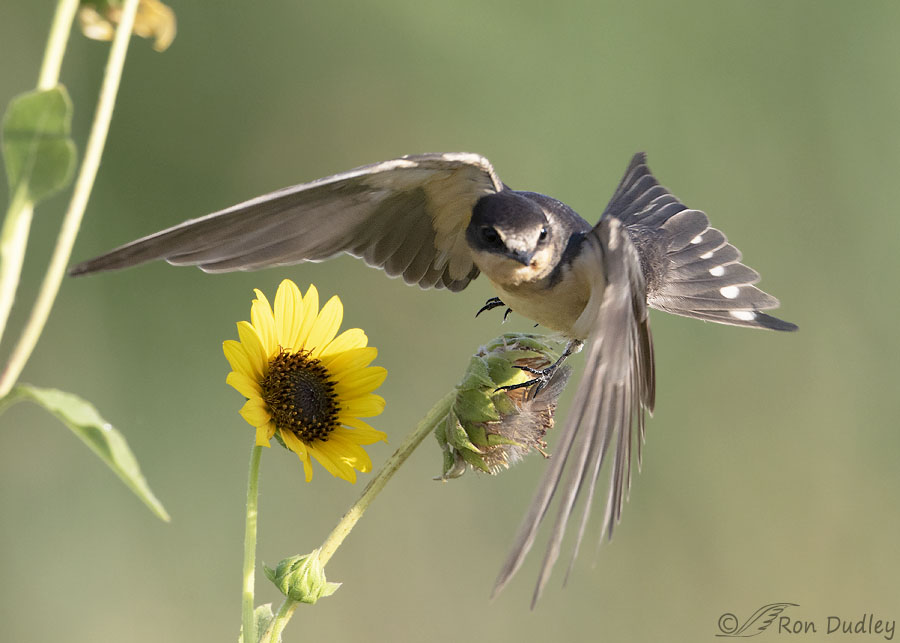
And to rub salt into the wound the exact same thing happened again that morning when this Barn Swallow took off from the sunflower. While perched the swallow had been facing to my left so I predicted it would take off in that direction and took my finger off of the focusing button. But the bird took off toward me and ruined my best laid plans.
In bird photography sure-fire strategies for getting songbirds sharp in flight simply don’t exist so all we can do is play the odds.
Sometimes it works and sometimes it doesn’t.
Ron


Wonderful series Ron!
Charlotte Norton
Thank you, Charlotte.
Good observations and thank you for sharing them. Covid has reduced my practice time and it is painfully obvious.
Thanks, Jane. Covid has ruined a lot of things hasn’t it.
Sometimes you’re the windshield; sometimes you’re the bug. 🙂 This was a fun lesson in strategy.
I’m so glad you didn’t cull the “non-catchlight” shot — it’s my favorite of the bunch because of the bird’s body/wing position. Tres elegant! And the next two “soft” shots only have a sort of softer R wing — the rest is sharp and again, the bird’s position in space is really interesting.
Funny you should mention that song, Marty. Mia and I mentioned it ourselves the morning these photos were taken.
Thank you. That makes a heap of sense – as does the fact that sometimes birds will defeat you anyway. Because they can.
Of course I echo other comments in saying that I am certain that I would be very proud to claim quite a lot your dustbin.
“sometimes birds will defeat you anyway”
For sure, Maybe more like usually than sometimes. Thanks, EC.
Thank you! I felt like I was behind the camera!
“I felt like I was behind the camera”
Now that made my day, Pat!
I’m glad! I’ll try to do it more often!
Well, regardless of “softness,” I do love the photo of that Barn Swallow with the 🌻. I suppose if it wasn’t quite so soft, we’d be able to tell for certain that’s a seed hanging from its beak. Still, I appreciate the beauty of the bird’s position, left foot still clinging to old flower head, tail uplifted, wings at the ready. Sweet!
Thanks, Chris. I would have liked it a lot with the colorful flower framed so well by the wings and the spent flower. But it wasn’t to be…
Ron,
Thank you for these excellent tips. Are you considering purchasing the Canon R5 with an adapter so that you can try out the animal eye focus?
It’s been getting some pretty good reviews for its ability to track birds.
Thanks, Den. Nope, not considering it. I plan on avoiding an adapter at almost any cost.
Den, I’ll explain further.
The R5 is full frame. I’d lose far too much reach using it, compounded by the fact that I’m highly reluctant to match a teleconverter to an adapter. That’s just too many electrical and mechanical connections that can go wrong and eventually some of them will. I know that in part from my recent experience with my 1.4 tc.
I think Canon pooched the screw when they abandoned the cropped frame 7D line.
Or something like that! 😉 🙂
Judy, that’s a Montana-ism from my growing up days. It just seemed to fit.
The ability of a a person to learn from their mistakes, know the limitations and peculiarities of their tools, and consistently create good work because of the former and despite the latter is my definition of a good craftsman. You’d be one of those, as evidenced by showing what you consider images not meeting your standards- though all of them are a cut above from my perspective- and enabling a deeper appreciation of your “keeper” photos.
Away, right/left, towards; do they not ever go up/down or diagonally?😀
“Away, right/left, towards; do they not ever go up/down or diagonally?”
Ha, I actually anticipated a comment like that from someone, Lyle. That’s why I said “There’s four BASIC directions they’re MOST LIKELY to take off”.
It’s called CYA… 🙂
And speaking of good craftsmen I love the way you crafted the first sentence in your comment.
Would have been better without the double a. Trying to learn from mistakes🥴
If flowed so well as written I didn’t even notice it and I read it three times.
I’m absolutely, positively CERTAIN your dustbin contains hoards of better photos than I could take. TRUST me on this. LOL!
Yeah, the best laid plans often go awry. That’s because if you make something that’s truly idiot proof, a better idiot will evolve. 😉
I’m headed off to Tucson to find Harris’ hawks–well, just one. Be back Saturday, so save your raptor shots for me. Y’all be safe, be well and be KIND!
“if you make something that’s truly idiot proof, a better idiot will evolve”
Laura, that’s kind of like one of my mantras – “If quality bird photography were easy everyone could do it”
Safe trip and good luck with the HH..
It IS frustrating BUT also a challenge to keep you on your toes…… 😉 There were a couple of GREAT photos “BUT”. Thx for sharing what you do/try to do with these situations………
Thank you, Judy.
Nice images. You can see the focus on the flower in the last image as the bird is moving out of the focal plane. Cheating the depth of field helps, however you lose the bokeh and typically with large primes and an open lens, that can be a narrow focal plane. I shoot with a Nikon D4 and use the continuous focus mode and the focus is on the shutter release not the back AF button. Assume Cannon is the same. I have had good success shooting that way. But all camera’s operate differently and the art, and fun, is figuring out how to use our equipment for the situation at hand. The pre-focus technique you described came in handy shooting baseball for me when my son was playing. Thanks for sharing your tips. I enjoy the technical aspect of how a shot is taken.
Thanks, Adam. Yes, there are different strategies and most of them work at least some of the time. I think the most important thing is to choose one of them and then stick with it in appropriate situations so you learn it and become skilled at it, almost like muscle memory.
I have to return after laughing at Jorge’s comment about the dustbin. Yes, that dustbin is probably a treasure chest of great photos. 🙂
Not…
Thank you for the tips. They are very useful.
And Ron I would be very happy if I had half of your dustbin contents…
Jorge, methinks my dustbin is in worse shape than you think… 🙂
Ah, the best laid plans of mice and men sometimes go astray!
Great shots!!
Sometimes? Ha, with bird photography it often seems more like usually. Thanks, Dick.
Very interesting information. Having neither the experience, skills, nor equipment that you have, I don’t even attempt song bird take-offs and in-flight photos. Any decent song bird take-offs or in-flight photos I get are accidental, but very welcome. Eagles I have gotten somewhat good at, but not song birds. It has always been a pleasure to come to your site to see your outstanding song bird shots.
Thanks, Everett. The size (and resulting quickness) of the bird makes a huge difference doesn’t it.